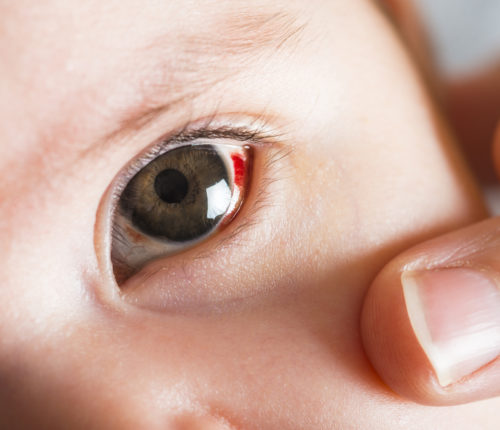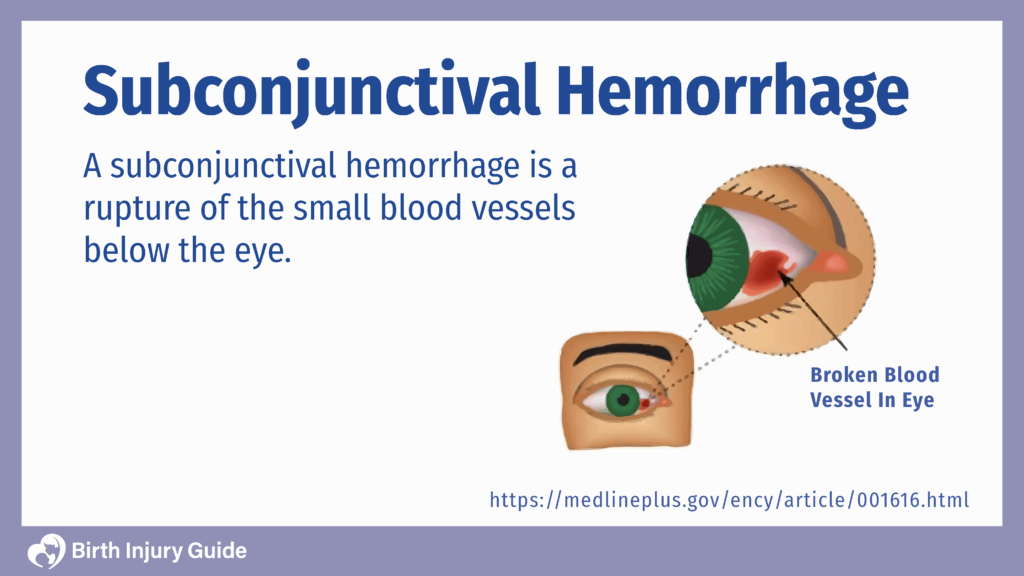
Infant Subconjunctival Hemorrhage (SCHN)
An infant subconjunctival hemorrhage (SCHN) is a medical condition that happens when the small blood vessels located just beneath the eye rupture. When a blood vessel ruptures, blood pools beneath the sclera (the clear membrane that covers the eye). The result is a bright red spot on the eye. This is sometimes called “red eye.”

Although a SCHN can happen at any age, it typically happens to newborn infants when trauma occurs during a stressful delivery. The injury can be scary for parents, but it is generally not traumatic. Many times, the red spot on the eye is the only sign of the injury. Infants often do not have pain or discomfort from the hemorrhage itself.
The Structures of the Eye
The white part of the eye is called the sclera. The thin, clear membrane that covers the sclera is called the bulbar conjunctiva. When an infant has SCHN, blood pools inside the conjunctiva.
What Are The Causes of SCHN?
SCHN are quite common in people of all ages. These injuries can happen for a variety of reasons – from a bad cough to a serious injury. Any sudden change in pressure on the blood vessels can cause them to rupture. In infants, these injuries are generally due to pressure on the head and face during delivery.
SCHN may occur during long, difficult labor when too much pressure is placed on the infant during contractions. As the infant moves through the birth canal, the head is under constantly changing pressure, which can be forceful during the delivery. This can cause the blood vessels in the eyes to rupture. This is most common in infants who are large for their gestational age, or who are having a hard time making their way down the birth canal.
In addition, injuries to the baby’s eyes can be caused by doctors applying inappropriate pressure and force on the infant during labor and delivery. This is more common when birth-assisting tools are used, such as forceps or a vacuum extraction tool. It can also happen if too much pressure is applied in order to release the infant’s shoulders if he or she is stuck during delivery. If your infant also has swelling on the head, he or she may also have a newborn hematoma under the skin. This condition is called cephalohematoma.
Subconjunctival Hemorrhage Symptoms
The most common symptom of infant subconjunctival hemorrhage is a bright red or dark red spot in the white of the eye. After a traumatic delivery, the eye usually shows redness right away or within a few hours. Sometimes, if enough blood vessels rupture, the redness will cover the entire white of the affected eye. It also may increase in severity over the next 24 hours after birth before tapering off. Since the blood is pooled underneath the conjunctiva, it cannot be wiped away and doesn’t move. The infant likely will not experience any pain or visual changes due to the hemorrhage, but your doctor should be aware of the injury. Sometimes SCHN is due to a physical injury, but it can also be a sign of another medical problem like high blood pressure or a viral infection.
Diagnosis of Infant Subconjunctival Hemorrhages
In most instances, a doctor can diagnose SCHN by simply looking at the infant’s affected eye. Usually, your baby will not need any tests. However, in some instances, doctors may monitor your baby’s blood pressure to make sure it is stable.
Subconjunctival Hemorrhage Treatment
Any type of injury to your baby’s eye can look terrifying and serious. The good news is that SCHN is generally not a reason to worry. In fact, there isn’t usually treatment necessary for SCHN as it usually clears up on its own within a few weeks or so. SCHN treatment at home may include artificial tears, which can help with itchiness and pain. Medications are generally not necessary. The best thing you can do is monitor how the eye is healing and contact your doctor if it looks like it is getting worse or is not improving.
In some cases, SCHN may lead to permanent eye damage, although this is extremely rare. In other instances, it may be a sign of other, more serious birth injuries. Since this injury can occur during labor and delivery, in many cases, the infant experiences other types of trauma as well. For example, facial paralysis is another birth injury that results from forceps use during delivery.
Prognosis for Infants
An infant subconjunctival hemorrhage should clear up on their own within a few weeks. However, if you don’t see any improvement during this time period, it’s important to contact your doctor immediately.
Be aware of the symptoms of a more serious eye condition, such as:
- Pus or thick discharge
- Swelling
- Fever
- Blood elsewhere in the eye
- Pain
- Signs of eye infection
If you notice any of these symptoms, talk to your doctor. The prognosis for any type of injury improves with timely diagnosis and treatment. Don’t be alarmed if your baby’s eyes turn yellow before clearing up. This is a normal part of the healing process as the body re-absorbs the blood.
More Information about Subconjunctival Hemorrhages
If you want to learn more about subconjunctival hemorrhages and how they affect newborns, take a look at these studies:
Birth-related subconjunctival and retinal haemorrhages in the Newborn Eye Screening Test (NEST) Cohort
This study examines subconjunctival and retinal hemorrhages and how they may be linked to birth trauma or birth injuries.
Subconjunctival hemorrhages in infants and children: a sign of nonaccidental trauma
This study examines how subconjunctival hemorrhages can be caused by intentional force, including birth trauma or child abuse.

